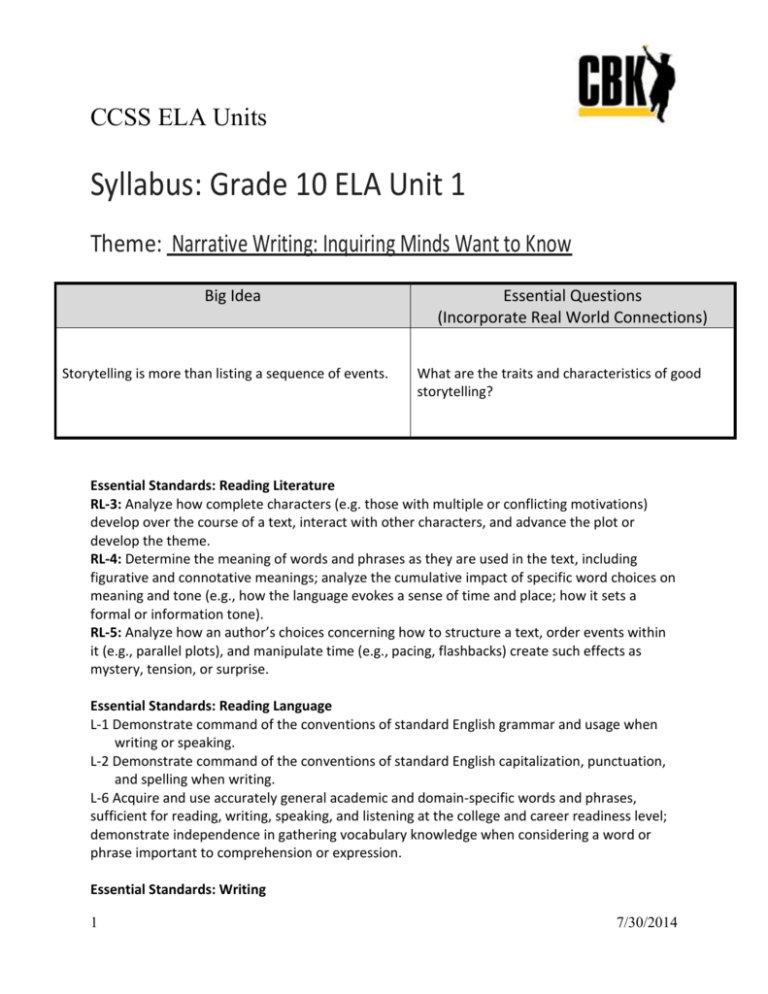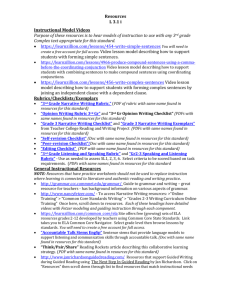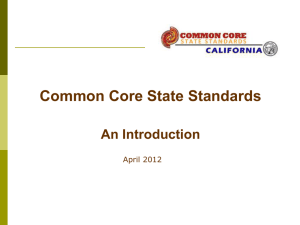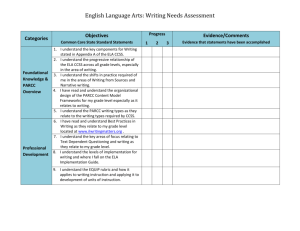Narrative Writing: Inquiring Minds Want to Know
advertisement

CCSS ELA Units Syllabus: Grade 10 ELA Unit 1 Theme: Narrative Writing: Inquiring Minds Want to Know Big Idea Storytelling is more than listing a sequence of events. Essential Questions (Incorporate Real World Connections) What are the traits and characteristics of good storytelling? Essential Standards: Reading Literature RL-3: Analyze how complete characters (e.g. those with multiple or conflicting motivations) develop over the course of a text, interact with other characters, and advance the plot or develop the theme. RL-4: Determine the meaning of words and phrases as they are used in the text, including figurative and connotative meanings; analyze the cumulative impact of specific word choices on meaning and tone (e.g., how the language evokes a sense of time and place; how it sets a formal or information tone). RL-5: Analyze how an author’s choices concerning how to structure a text, order events within it (e.g., parallel plots), and manipulate time (e.g., pacing, flashbacks) create such effects as mystery, tension, or surprise. Essential Standards: Reading Language L-1 Demonstrate command of the conventions of standard English grammar and usage when writing or speaking. L-2 Demonstrate command of the conventions of standard English capitalization, punctuation, and spelling when writing. L-6 Acquire and use accurately general academic and domain-specific words and phrases, sufficient for reading, writing, speaking, and listening at the college and career readiness level; demonstrate independence in gathering vocabulary knowledge when considering a word or phrase important to comprehension or expression. Essential Standards: Writing 1 7/30/2014 CCSS ELA Units W-3a Write narratives to develop real or imagined experiences or events using effective technique, well-chosen details, and well-structured event sequences. a. Engage and orient the reader by setting out a problem, situation, or observation, establishing one or multiple point(s) of view, and introducing a narrator and/or characters; create a smooth progression of experiences or events. W-3b Use narrative techniques, such as dialogue, pacing, description, reflection, and multiple plot lines, to develop experiences, events, and/or characters. W-3d Use precise words and phrases, telling details, and sensory language to convey a vivid picture of the experiences, events, setting, and/or characters. W-3e Provide a conclusion that follows from and reflects on what is experienced, observed, or resolved over the course of the narrative. W-6 Use technology, including the Internet, to produce, publish, and update individual or shared writing products, taking advantage of technology’s capacity to link to other information and to display information flexibly and dynamically. Student Assignments Assignment 1: The Necklace - Green Literature Book Read: Learn About Character p. 30 Read: The Necklace pp. 31-38 Answer Questions 1-2 p. 30 Answer “Think About Character” Questions p. 41 Complete “Predict Outcomes” worksheet. P. 10 Complete “Develop Your Vocabulary” section of Review the Selection. p. 41 Complete “Word List” work from Comprehension and Vocabulary Workbook. P. 9 Complete Writing Connection p. 30 REQUIRED: use 5-7 vocabulary words from the story vocabulary list. Assignment 2: Memoirs: Edge Orange Level The Right Words at The Right Time by John Leguizamo, Assign activities from EDGE Resources Assign lessons and modules from Plato “RCOE Grade 10 Unit 1” Resource located under local content. (teacher assignments based on individual student needs) Assignment 3: Biographies: Up From Slavery: An Autobiography by Booker T. Washington (teacher selected passages) Optional Study Questions Up From Slavery Write an autobiography about an event in your life. Plan your writing using the graphic organizer provided in Student Resources. Edit your writing using the Narrative Essay Revising & Editing Guide in student resources. Submit your autobiography at http://www.paperrater.com/ for a final check before submitting it to your teacher. 2 7/30/2014 CCSS ELA Units Assignment 4: Use Dictionary.com to find or create a word list. Play a game with the vocabulary words in Unit 1 Student Resources. Print your score from a game if you earned at least 80%. Assignment 5: Search You Tube for information on writing narrative essays. Compile a list of a minimum of three videos which helped you understand the narrative essay writing process. Compose an annotated list of your resources and submit your annotated resource list to Haiku. Watch Video “Writing Process Animation” https://www.youtube.com/watch?v=V1pnpL8295E&feature=player_detailpage Write a blog post about one of the following: A time you made a difference in the life of another person. A time you solved a challenging predicament. A personality trait that will help you succeed. A time you felt grateful Propose your own idea to your teacher Submit your blog to your teacher for posting on the student blog page of our Class Haiku page. Assessment Oars Inspect Grade 10 Unit I ELA Assessment (required) 3 7/30/2014 CCSS ELA Units Student Resources Academic Vocabulary Tier 2 Words earnest philanthropy zeal notwithstanding stagnate prudent resolve superficial cease forbearance comedian career react obstacle obnoxious paraphrase commerce appraise dabble bemuse derogatory recumbent fascinate maul subside meager cower 4 Tier 3 Words analyze conflicting complex theme acquire theme academic domain-specific comprehension expression structured engage narrator progression reflection vivid manipulate evokes 7/30/2014 CCSS ELA Units 5 7/30/2014 CCSS ELA Units Narrative Essay Revising & Editing Guide 1. Check for complete sentences. Do you have a subject? Do you have a verb? Do you have a complete thought? Do you have a run-on or a fragment? 2. Eliminate run-ons and fragments. Read each sentence one at a time starting at the end of your paper. You are not looking for continuity of thought here – just checking for run-ons and fragments. Run-ons go on & on and usually have two or more thoughts that are not joined properly. Fragments are usually either • missing a subject or a verb OR • begin with a conjunction like because, when, since. 3. Check sentence variety in each paragraph. Are the sentences in the paragraph all short or all long? Are there any sentences you can combine? 4. Circle conjunctions. And, or, but, for, nor, so, yet What are you joining with the conjunction? Words, phrases, or sentences? 5. Check commonly confused words. Its/it’s Your/you’re There/their/they’re Affect/Effect For more, check out the resources in your classroom – ask your teacher. 6. Check for subject-verb agreement. Subject and verb “match.” Ex: I run everyday. She runs everyday. 7. Check for pronoun-antecedent. Can you tell who is “he,” “she” or “they”? Can you tell what is “it,” “that” or “this”? The pronoun should refer to the last noun (antecedent) you used before the pronoun. 8. Check for dead words. 6 7/30/2014 CCSS ELA Units Avoid simple or overused words like got, is, was, things, stuff... Use your thesaurus to find a better word. 9. Check for misspelled words. Circle them. Look them up in dictionary & correct. 10. Check for punctuation. Use a comma (,) • Between two sentences before “and” or “but” or other conjunctions (see item 15 on this list) • Between words in a series of 3 or more items. • After an introductory phrase. Use a period (.), question mark (?), or exclamation point (!) at the end of a sentence. 11. Check for capitalization. First letter of a sentence Proper names Titles (book, magazine, newspaper, movie) 7 7/30/2014 CCSS ELA Units Extension Activities or Final Course Essay/Project Dream of a Nation http://dreamofanation.org/educators/the-book/ 1. Read Students should begin by reading several narrative essays found in Dream of a Nation. Students can self-select two or three articles from the articles below Painting Hope in the World by Lily Yeh (chapter 12) Realizing Our Roots and the Power of Interconnectedness by Mona Polacca (chapter 12) War and Ending It by Michael T. McPhearson (chapter 11) Transforming Urban Injustice into Beauty and Empowerment by Majora Carter (chapter 10) As Long as It’s Been by Irene Mabry Moses (p.262, chapter 8) Building a Conservation Nation by Jeff Barrie (chapter 6) Seeing Education in a New Light by Geoffrey Canada (chapter 5) Helping Others: Finding the Will and the Way by Sejal Hathi (chapter 2) As students read they should take notes on how the authors structure the narrative essays. Students should notice: -What personal experience the author references -How this personal experience connects with the larger social issue the author addresses -What facts the author gives about the social issue -What details the author gives about their personal experience -How the connection between personal experience and facts makes the reader connect and care about the social issue discussed 2. Picking a Social Issue Students should pick an issue which has directly affected their lives. Brainstorm the various societal issues people could confront. Students pick two or three issues and make a list of life events which have been affected by these issues. Encourage them to be specific in terms of a moment. For example, instead of writing “poverty” have students write “last Christmas”. After they have made these lists then have them selected the situation about which they can recall the most details. This will be the social issue and the personal event which provide the content for their narrative essay. 8 7/30/2014 CCSS ELA Units 3. Gather Facts Once students have a social topic selected they should do some research on this topic in order to provide facts for their narrative essay. Facts can be found on the Dream of a Nation website. Students can look at the Solutions and Actions page. Have students first select the chapter and then the article which pertains most directly to their issue. These pages feature videos, partner organization websites and answers to pertinent questions from which students can draw relevant information. Students should take notes on facts using the Issue Fact Notes Handout. They should write down facts they find interesting but remind them that not all facts may find their way into their essays. They should only include the facts which are the most relevant and persuasive in their final essays. 4. Write down the Details Have them model their essay on one of the narrative essays they read. Using the notes they took on those essays have them include examples for their own essay, using their experiences which contain all of the applicable methods: sensory details, examples of sarcasm, irony, bits of dialogue, point of view 5. Writing, Editing and Revising The first sentence of any story is oftentimes the most difficult for students to write. To help them get started give them the Ernest Hemingway six word story: “For sale: Baby shoes. Never worn.” Have them develop their own six word stories using the topic and the style they chose for their narrative essay. They should share these with the class. Then, have the students use these sentences for the first sentences of their story. Students should be encouraged to find a writing partner in their class who they can share their writing with on an ongoing basis. Once they have several pages— and before they are finished—they should meet in writer’s workshop to listen to and discuss each other’s stories. They read their story aloud. The listener can take notes. After the reader is done the first round of comments are positive. Listeners detail the specific elements in the writing they enjoyed and explain why. The second round of comments are constructive criticism and should be focused on a specific point in the text the listener details to the writer. The writer should take notes on what the listeners say—both positive and constructive 9 7/30/2014 CCSS ELA Units comments. Students can participate in writer’s workshop however many times they want throughout the writing process. Some writer’s find it immensely helpful to workshop when they get stuck. Peer proofreading should occur when the students think they are finished. Use the Narrative Editing Guide to help the peer reader check the story. 6. Evaluation Use the RCOE Essay Rubric for evaluation of student work. Partial points can be awarded for each category. Studentscan submit their narrative essays as op-ed articles for a local newspaper or online teen magazine or news source. Here are some possible magazines for teens to submit their work: Student Essays can be posted on Haiku. Cicada Teen Ink YARN Polyphony H.S. 10 7/30/2014 CCSS ELA Units Grade Sheet ELA 10 Unit 1 Name_________________ Assignment Activity 1 Activity 2 Activity 3 Final The Necklace (req) Right Words at the Right Time (req) Plato Assignments Up from Slavery Study Questions Personal Narrative Graphic Organizer (req) Student Autobiography (req) Dictionary com Annotated Resource List (req) Blog (req) CCSS ELA Grade 10 Unit 1 Assessment (req) Extension or Supplemental 11 7/30/2014







